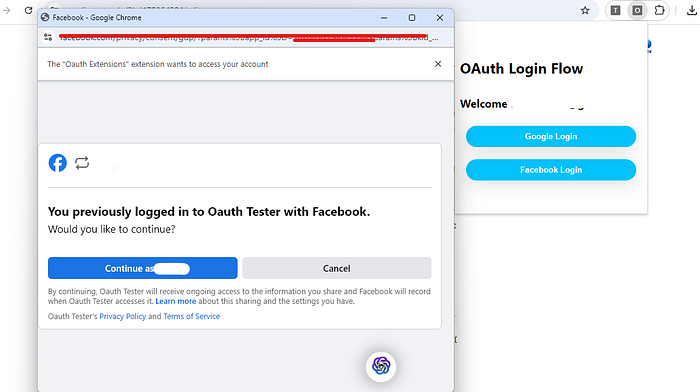
By using the chrome.identity API it enables use to identify/retrieve signed-in users, authenticate via Google OAuth or other social OAuth options, get access token tokens and more.
In this article we are going to cover how to initial a login sequence for Facebook and Google using the chrome.identity API. You see the official documentation on the API here: https://developer.chrome.com/docs/extensions/reference/api/identity
How to declare it in Manifest.json
{
...
"permissions" : [
"identity"
],
...
}
How to get Account Details
If you want want the details for a user signed into chrome. First add the identity.email permission in the manifest along side the identity permission.
{
...
"permissions" : [
"identity",
"identity.email"
],
...
}
Next is by call the the chrome.identity.getProfileUserInfo function. If the user is signed it will return the email and gaia id . There are only 2 options for accountStatus ANY or SYNC.
chrome.identity.getProfileUserInfo({ accountStatus: "ANY" }, (user) => {
console.log(user.email);
console.log(user.id);
})
// or async/await version
const user = await chrome.identity.getProfileUserInfo({ accountStatus: "ANY" });
console.log(user.email);
console.log(user.id);
To Detect if an account was change you can use the event listener onSignInChanged
// Fired when signin state changes for an account on the user's profile.
chrome.identity.onSignInChanged.addListener((account, signedIn) => {
if (signedIn) {
console.log(account.id);
}
})
How to Launch a Login Flow
We’ll use Facebook as an example.
Prerequisites
You’d at least need to know the basics of how OAuth 2.0 works and have a general understadning of what access_token, refresh_token, redirect_url, client_id and client_secrets are. Or better yet have implemented a OAuth Login on website or webapp.
Start the Dialog
Ever social login requires the user to go the oauth page to start the login process. The identity API aids us by giving us the chrome.identity.launchWebAuthFlow function that does exactly just that. It will launch a web view window to the oauth page we want.
const client_id = '';
const redirectUrl = "";
const authUrl = ``;
// https://developer.chrome.com/docs/extensions/reference/api/identity#method-launchWebAuthFlow
const options = {
// The URL that initiates the auth flow.
url: authUrl,
}
// Start web view
chrome.identity.launchWebAuthFlow(options, (responseUrl) => {
if (responseUrl) {
// Get tokens,code or othe values from url
}
});
Okay let’s explain what is happening here. For the a conventional oauth login flow the user will have to be direct to a URL that usually contains the client_id, scopes and redirect_url in any format like this
const client_id = '';
const redirectUrl = "";
const scopes = ""
const authUrl = `https://app.example.com/oauth?client_id${client_id}&redirectUrl=${redirectUrl}&scopes=${scopes}`;
The client_id and scopes are values you can getting from the platform you are registering for. However a question you might have is “what do I put in the redirect Url?”
Redirect Url
As the name implies the redirect url is the url the user is redirected to when the login for is complete and usually code and tokens are attached along side the url when the user is redirected.
https://redirecturl.com?code=SomeRandomCode&token=OrSomeRandomToken
The redirect url is usually something you’d know before hand it is a requirement for you need to enter in the social platform that you want to make a login for.
For chrome extensions the is a special format used https://<app-id>.chromiumapp.org/* . And this is the redirect url that you will need to but in the social platform you are targeting.

Where to get the app id

const id = chrome.runtime.id
const redirectUrl = `https://${id}.chromiumapp.org/callback`
// or use the getRedirectURL
const redirectUrl = chrome.identity.getRedirectURL('callback');
What happens after the web view reaches the redirect url
When the web view reaches this redirect extension will close automatically and the callback function is called. So let as review that code again but will use Facebook as an example
const clientId = '12345******';
const redirectUrl = chrome.identity.getRedirectURL('callback');
const authUrl = `https://www.facebook.com/v20.0/dialog/oauth?`+
`client_id=${clientId}`+
`&redirect_uri=${redirectUrl}`+
`&state=randomState`
const options = {
url: authUrl, // The URL that initiates the auth flow.
}
// Start web view
chrome.identity.launchWebAuthFlow(options, (responseUrl) => {
if (responseUrl) {
// Get tokens,code or othe values from url
}
});
The responseUrl will usually contain the codes and token that you need to make authenticated requests. Although you’d need to use some JavaScript trickery to get them as there are appended as query params https://904823.chrome..chromiumapp.org/callback?token=whatyouwant
Google Oauth
You can able the sample methodology for the Google OAuth flow, however the are special functions in the chrome.identity for Google OAuth which make it more convient. It done require some setting up to do though.
Here is a guide a how to set up your Google Console Project for chrome extensions. https://developer.chrome.com/docs/extensions/how-to/integrate/oauth. So go do that first.
You’re back? Alright for 10% of y’all who did it. You can now use the chrome.identity.getAuthToken function initiate a special popup for Google OAuth. and the callback has the access token from authenticate requests.
// For more options - https://developer.chrome.com/docs/extensions/reference/api/identity#type-TokenDetails
const options = {
// show popup if necessary
interactive: true,
// by default it uses the ones declared in manifest.json
scopes: []
};
chrome.identity.getAuthToken(options, (accessToken) => {
// make request with access token
});
To De-authorizes the user
chrome.identity.clearAllCachedAuthTokens(() => {
});
// or async/await version
await chrome.identity.clearAllCachedAuthTokens()
Sample Project
In this project we are going to build a base framework for an extension with a Google and Facebook login page and a main page once they have logged in.
You can access the source code to the project here: https://github.com/BuildChromeExtensions/chromeGoogleOAuth



We will need 5 file for this one: manifest.json, index.html, scripts.js , main.html and main.js.
You’ll need to replace the client_id for Google in manifest.json and the client_id for Facebook in the script.js with your own.
manifest.json
{
"name": "Oauth Extensions",
"description": "Test Loging flow with this extensions",
"version": "1.0.0.0",
"manifest_version": 3,
"oauth2": {
"client_id": "***************.apps.googleusercontent.com",
"scopes": [
"profile",
"email"
]
},
"action": {
"default_popup": "index.html"
},
"permissions": [
"identity",
"identity.email"
]
}
index.html
<!DOCTYPE html>
<html lang="en">
<head>
<meta charset="UTF-8">
<meta name="viewport" content="width=device-width, initial-scale=1.0">
<title>Document</title>
<style>
body {
width: 300px;
height: 300px;
display: flex;
flex-direction: column;
justify-content: center;
}
button {
background: #03c2fc;
color: #ffffff;
padding: 10px 20px;
border: none;
cursor: pointer;
box-shadow: rgba(100, 100, 111, 0.2) 0px 7px 29px 0px;
transition: all 0.4s;
border-radius: 30px;
font-weight: 700;
margin: 10px;
}
button:hover {
background: #026482;
}
</style>
</head>
<body>
<h1>OAuth Login Flow</h1>
<h2></h2>
<button id="btn-google">Google Login</button>
<button id="btn-facebook">Facebook Login</button>
<script type="text/javascript" src="./scripts.js"></script>
</body>
</html>
scripts.js
chrome.identity.getProfileUserInfo({ accountStatus: "ANY" }, (user) => {
console.log(user);
if (user.email) {
document.querySelector('h2').textContent = `Welcome ${user.email}`;
}
})
document.getElementById('btn-google').onclick = async () => {
// For more options - https://developer.chrome.com/docs/extensions/reference/api/identity#type-TokenDetails
const options = {
interactive: true, // show popup if necessary
// by default it uses the ones declared in manifest.json
// scopes: []
/*The account ID whose token should be returned.
If not specified, the function will use an account
from the Chrome profile: the Sync account if there
is one, or otherwise the first Google web account.
*/
// account: {
// id: ""
// }
}
chrome.identity.getAuthToken(options, (accessToken) => {
console.log(accessToken);
chrome.action.setPopup({ popup: "main.html" });
window.location.href = "main.html";
});
}
document.getElementById('btn-facebook').onclick = () => {
const clientId = '**********';
const redirectUrl = chrome.identity.getRedirectURL('callback');
const authUrl = `https://www.facebook.com/v20.0/dialog/oauth?` +
`client_id=${clientId}` +
`&redirect_uri=${redirectUrl}` +
`&state=randomState`
// https://developer.chrome.com/docs/extensions/reference/api/identity#method-launchWebAuthFlow
const options = {
// The URL that initiates the auth flow.
url: authUrl,
interactive: true,
abortOnLoadForNonInteractive: true,
timeoutMsForNonInteractive: 60000,
}
// Start web view
chrome.identity.launchWebAuthFlow(options, (responseUrl) => {
console.log(responseUrl)
if (responseUrl) {
// Get tokens,code or othe values from url
const containsCode = responseUrl.indexOf("code") != -1;
if (containsCode) {
chrome.action.setPopup({ popup: "main.html" });
window.location.href = "main.html";
}
}
});
}
main.html
<!DOCTYPE html>
<html lang="en">
<head>
<meta charset="UTF-8">
<meta name="viewport" content="width=device-width, initial-scale=1.0">
<title>Document</title>
<style>
body {
width: 300px;
height: 300px;
display: flex;
flex-direction: column;
text-align: center;
justify-content: center;
background: #a30520;
color: white
}
button {
background: #fc03ad;
color: #ffffff;
padding: 10px 20px;
border: none;
cursor: pointer;
box-shadow: rgba(100, 100, 111, 0.2) 0px 7px 29px 0px;
transition: all 0.4s;
border-radius: 30px;
font-weight: 700;
margin: 10px;
}
</style>
</head>
<body>
<h2><b>You've Login In Successfully</b></h2>
<button>Logout Out</button>
<script type="text/javascript" src="./main.js"></script>
</body>
</html>
main.js
document.querySelector('button').onclick = () => {
// Logged
chrome.identity.clearAllCachedAuthTokens(() => {
chrome.action.setPopup({ popup: "index.html" });
window.location.href = "index.html";
});
}






